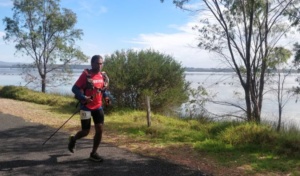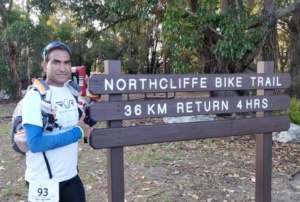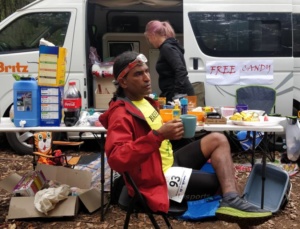The Delirious W.E.S.T. is considered the longest, single-stage race in the southern hemisphere. And it’s name suggests just how testing it is. Here’s how Brijmohan “Breeze” Sharma pulled off the epic.

First published:
https://www.firstpost.com/living/runners-high-how-brijmohan-breeze-sharma-completed-a-daunting-200-mile-race-in-australia-6244301.html
Runner’s high: How Brijmohan ‘Breeze’ Sharma completed a daunting 200-mile race in Australia
When Sharma crossed the line in 95 hours and 39 minutes, he became the first Indian to successfully finish a timed and tracked 200-miler outside of India.
There are those who are happy to bask in the glory of feats they have accomplished, and then there are those who cannot sleep easy because they dream of continually redefining boundaries. Brijmohan “Breeze” Sharma belongs to the second category.
A mountaineer at heart, Sharma reached the summit of Manaslu on 28 September last year. It was the third 8,000-er that he had climbed after Mount Everest and Lhotse. A few days after his return and he was already restless, in anticipation of the realisation of his next project. What caught his attention next was a race.
The Delirious W.E.S.T. is a single-stage, 218-mile race (350.7 kilometres) that runs along the Bibbulman Track in Western Australia, with a 104-hour cutoff for a successful finish. The trail runs through bush forests and along virgin beaches, with few signs of civilisation along the way.
When Sharma crossed the line in 95 hours and 39 minutes, he became the first Indian to successfully finish a timed and tracked 200-miler outside of India. Of the 43 runners, only 28 managed to get across the finish line; Sharma finished in the 21st position.

“After Manaslu, I thought of testing my endurance against something special. I’ve done 19 100-mile races so far, and wanted to improve on that mark. So when this race popped up, I wrote to them with my credentials and was glad when they extended an invitation,” Sharma says.
Sharma boasts of a commendable resume, given that he started running just six years ago. In July 2016, he took on the gruelling 135-mile Badwater Ultra that runs through Death Valley in the US, where temperatures can reach over 50 degrees Celsius. To qualify for the race, he had to run three 100-milers. He followed that up with the Brazil 135 in February 2018. Besides these, the longest distance that he’s undertaken so far was during a stage race — the 338-kilometre Himalayan Crossing, in addition to an unofficial run between Mumbai and Shirdi (around 280 kilometres).
“I was very interested in the distance because I wanted to figure out the breaking point of my body. That never came, as I comfortably reached the finish,” he says, grinning.
In the run-up to the Delirious W.E.S.T., Sharma took on the strenuous 85-mile Oman by UTMB race in November-December of last year, which he calls “more mountaineering than running” due to the terrain that involved a vertical gain of 7,800 metres (Mount Everest is 8,850 metres). He ran a sub-24 hour race while finishing second in the 100-mile category at The Border race in Jaisalmer in December. The following month, he ran the 42.195 kilometre distance at the Mumbai Marathon.

Sharma credits his performance to the rigorous training regime that he adopted a couple of months before the race. “Since I was working on my endurance, it equated to training longer — greater distances and more repetitions. Then again, I was really curious to know how my body would react beyond the maximum distance that I had previously run,” Sharma says.
He increased the daily distance to be covered to about 50 kilometres on average, adding up to a weekly mileage of around 300 kilometres. There were also days when he would run 64 kilometres between his home in Kanjurmarg and office at the Naval Dockyard in Fort, while also attending to work in between. A third of the day was dedicated only to training. And along the way, he also had to sort out the finances for the entire trip. “You need specific gear for this race; just the shoes cost me Rs 30,000, and I needed two pairs. Then the nutrition added up to around Rs 25,000. Running a race such as this one is impossible without financial and social support, besides knowing how to manage time. If you can put in these kind of sacrifices, you will succeed,” Sharma says.
At the start point, Sharma lined up alongside more experienced runners, whom he had been following over the years for their exploits. To cut down on the costs, he opted to go without a pacer and a crew member. Nerves, if any, disappeared the moment he took off at 7 am on 20 February.
“It was the most gorgeous terrain to soak in — different birds by day and night, flowers that I had never seen before, and trees that seemed to reach the sky. Every now and then, I would be in the company of wildlife such as kangaroos, emus, snakes and frogs. It had me engrossed, for nothing pleases me more than running alone alongside the wonders of nature,” Sharma says.

Once the sun went down, the headlamp lit up little creatures scampering across the pathway, while the thick foliage came to life with its own symphony. It wasn’t all rosy though, as the first obstacle arrived around the 200 kilometre mark, some 45 hours into the race. Sharma lost track of the path and went around in circles for a good four hours. “It was the middle of the night and I just couldn’t find the route marker. The organisers could see me struggling on their monitors, so they called me and asked me to follow north. But I couldn’t figure out directions, and eventually had to wait for a trailing runner to put me back on the right path,” he says.
On another couple of occasions, Sharma lost time when he went off track yet again. “In all, I lost eight hours. It was very frustrating and I thought of dropping out of the race. At times, all the training that you put in cannot help you resolve incidents that happen during the race,” he says.
But at the back of his mind, he thought of all the people who were following his progress online, and the fact that he was representing India at an international event of such a high grade. It was reason enough for him to battle on. When he needed it the most, it was the folks manning aid stations who cheered him on, especially when they had some Indian food to offer, which was nothing short of a delight at that point. “They were out with their families and had decorated the place like we do during Diwali. I was really amazed to see them dish out fresh food, I relished the omelettes and soups on offer. Imagine my surprise when I found dal, khakra and aachar at one of the aid stations. The moment they realised that there was an Indian running, they made it all available and I was really grateful to them, for it offered me great comfort,” he says.
On just four hours of sleep, Sharma fought on to get past a distance that he had previously achieved. The fatigue disappeared, as did the thought of running the remaining miles. “It’s a kind of meditation and it doesn’t matter whether you are running, walking or sleeping. There is no pain. Everything in the material world slowly fades away and it’s all serene. You are in a different zone where there’s only peace,” he recalls.
After going past the last of the 24 aid stations, Sharma had 11 kilometres to negotiate. He estimated a good three hours to go the distance, but found this new energy that helped him sail across the terrain. By the end of it, he had covered the final stretch in just an hour and 39 minutes. “And just like that, the fatigue disappeared. It was a feeling that I have never experienced before,” he says.
“It’s pure torture, a punishment really. But I cannot wait to do it again,” he adds. The daunting task of raising funds for his next project has already begun. And if all goes well, Sharma will hope to take the tricolour up to Kanchenjunga, come summer.